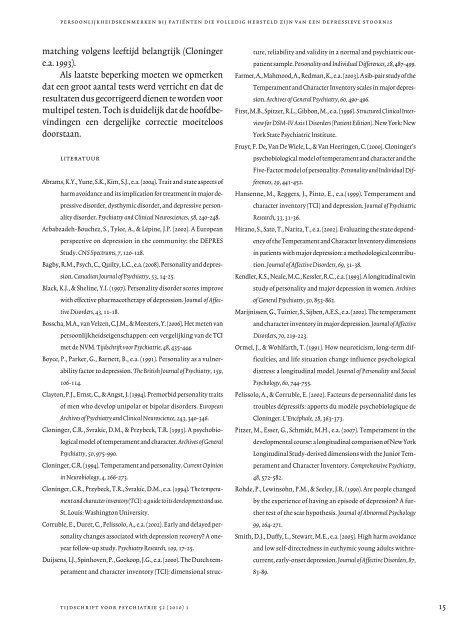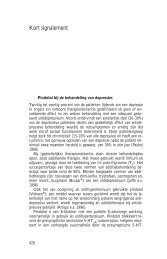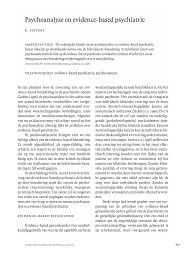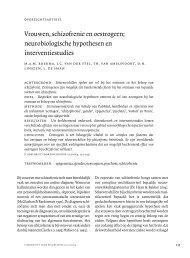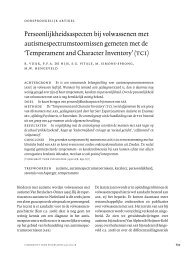volledige tekst - Tijdschrift voor Psychiatrie
volledige tekst - Tijdschrift voor Psychiatrie
volledige tekst - Tijdschrift voor Psychiatrie
You also want an ePaper? Increase the reach of your titles
YUMPU automatically turns print PDFs into web optimized ePapers that Google loves.
persoonlijkheidskenmerken bij patiënten die volledig hersteld zijn van een depressieve stoornis<br />
matching volgens leeftijd belangrijk (Cloninger<br />
e.a. 1993).<br />
Als laatste beperking moeten we opmerken<br />
dat een groot aantal tests werd verricht en dat de<br />
resultaten dus gecorrigeerd dienen te worden <strong>voor</strong><br />
multipel testen. Toch is duidelijk dat de hoofdbevindingen<br />
een dergelijke correctie moeiteloos<br />
doorstaan.<br />
literatuur<br />
Abrams, K.Y., Yune, S.K., Kim, S.J., e.a. (2004). Trait and state aspects of<br />
harm avoidance and its implication for treatment in major depressive<br />
disorder, dysthymic disorder, and depressive personality<br />
disorder. Psychiatry and Clinical Neurosciences, 58, 240-248.<br />
Arbabzadeh-Bouchez, S., Tylee, A., & Lépine, J.P. (2002). A European<br />
perspective on depression in the community: the DEPRES<br />
Study. CNS Spectrums, 7, 120-128.<br />
Bagby, R.M., Psych, C., Quilty, L.C., e.a. (2008). Personality and depression.<br />
Canadian Journal of Psychiatry, 53, 14-25.<br />
Black, K.J., & Sheline, Y.I. (1997). Personality disorder scores improve<br />
with effective pharmacotherapy of depression. Journal of Affective<br />
Disorders, 43, 11-18.<br />
Bosscha, M.A., van Velzen, C.J.M., & Meesters, Y. (2006). Het meten van<br />
persoonlijkheidseigenschappen: een vergelijking van de TCI<br />
met de NVM. <strong>Tijdschrift</strong> <strong>voor</strong> <strong>Psychiatrie</strong>, 48, 435-444.<br />
Boyce, P., Parker, G., Barnett, B., e.a. (1991). Personality as a vulnerability<br />
factor to depression. The British Journal of Psychiatry, 159,<br />
106-114.<br />
Clayton, P.J., Ernst, C., & Angst, J. (1994). Premorbid personality traits<br />
of men who develop unipolar or bipolar disorders. European<br />
Archives of Psychiatry and Clinical Neuroscience, 243, 340-346.<br />
Cloninger, C.R., Svrakic, D.M., & Przybeck, T.R. (1993). A psychobiological<br />
model of temperament and character. Archives of General<br />
Psychiatry, 50, 975-990.<br />
Cloninger, C.R. (1994). Temperament and personality. Current Opinion<br />
in Neurobiology, 4, 266-273.<br />
Cloninger, C.R., Przybeck, T.R., Svrakic, D.M., e.a. (1994). The temperament<br />
and character inventory(TCI): a guide to its development and use.<br />
St. Louis: Washington University.<br />
Corruble, E., Duret, C., Pelissolo, A., e.a. (2002). Early and delayed personality<br />
changes associated with depression recovery? A oneyear<br />
follow-up study. Psychiatry Research, 109, 17-25.<br />
Duijsens, I.J., Spinhoven, P., Goekoop, J.G., e.a. (2000). The Dutch temperament<br />
and character inventory (TCI): dimensional struc-<br />
ture, reliability and validity in a normal and psychiatric outpatient<br />
sample. Personality and Individual Differences, 28, 487-499.<br />
Farmer, A., Mahmood, A., Redman, K., e.a. (2003). A sib-pair study of the<br />
Temperament and Character Inventory scales in major depression.<br />
Archives of General Psychiatry, 60, 490-496.<br />
First, M.B., Spitzer, R.L., Gibbon, M., e.a. (1996). Structured Clinical Interview<br />
for DSM-IV Axis I Disorders (Patient Edition). New York: New<br />
York State Psychiatric Institute.<br />
Fruyt, F. De, Van De Wiele, L., & Van Heeringen, C. (2000). Cloninger’s<br />
psychobiological model of temperament and character and the<br />
Five-Factor model of personality. Personality and Individual Differences,<br />
29, 441-452.<br />
Hansenne, M., Reggers, J., Pinto, E., e.a.(1999). Temperament and<br />
character inventory (TCI) and depression. Journal of Psychiatric<br />
Research, 33, 31-36.<br />
Hirano, S., Sato, T., Narita, T., e.a. (2002). Evaluating the state dependency<br />
of the Temperament and Character Inventory dimensions<br />
in patients with major depression: a methodological contribution.<br />
Journal of Affective Disorders, 69, 31-38.<br />
Kendler, K.S., Neale, M.C., Kessler, R.C., e.a. (1993). A longitudinal twin<br />
study of personality and major depression in women. Archives<br />
of General Psychiatry, 50, 853-862.<br />
Marijnissen, G., Tuinier, S., Sijben, A.E.S., e.a. (2002). The temperament<br />
and character inventory in major depression. Journal of Affective<br />
Disorders, 70, 219-223.<br />
Ormel, J., & Wohlfarth, T. (1991). How neuroticism, long-term difficulties,<br />
and life situation change influence psychological<br />
distress: a longitudinal model. Journal of Personality and Social<br />
Psychology, 60, 744-755.<br />
Pelissolo, A., & Corruble, E. (2002). Facteurs de personnalité dans les<br />
troubles dépressifs: apports du modèle psychobiologique de<br />
Cloninger. L’Encéphale, 28, 363-373.<br />
Pitzer, M., Esser, G., Schmidt, M.H., e.a. (2007). Temperament in the<br />
developmental course: a longitudinal comparison of New York<br />
Longitudinal Study-derived dimensions with the Junior Temperament<br />
and Character Inventory. Comprehensive Psychiatry,<br />
48, 572-582.<br />
Rohde, P., Lewinsohn, P.M., & Seeley, J.R. (1990). Are people changed<br />
by the experience of having an episode of depression? A further<br />
test of the scar hypothesis. Journal of Abnormal Psychology<br />
99, 264-271.<br />
Smith, D.J., Duffy, L., Stewart, M.E., e.a. (2005). High harm avoidance<br />
and low self-directedness in euthymic young adults withrecurrent,<br />
early-onset depression. Journal of Affective Disorders, 87,<br />
83-89.<br />
tijdschrift <strong>voor</strong> psychiatrie 52 (2010) 1 15


